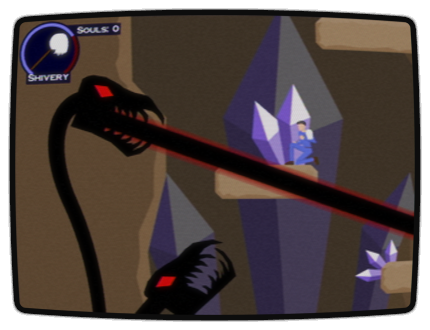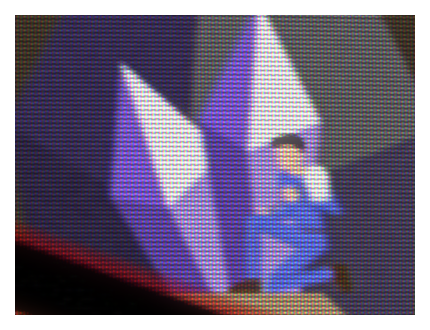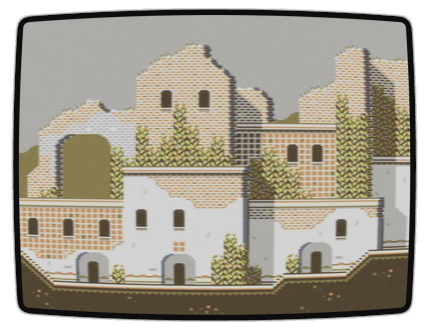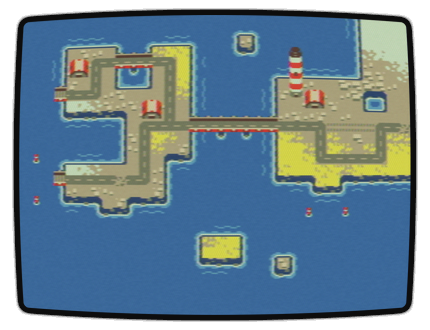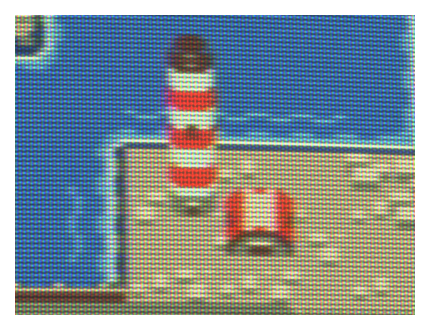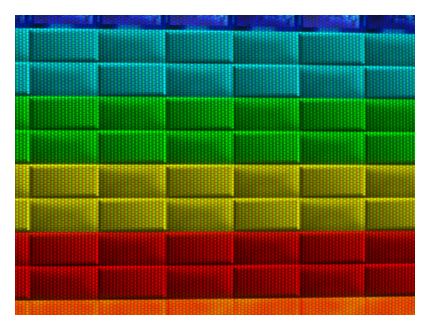Cathode Retro is a collection of shaders that combine to emulate the properties and artifacts of a color NTSC TV signal as well as the visual look of a Cathode-Ray Tube (CRT) TV.
(click screenshots for full-sized version)
Screenshot from Mop of Destiny
Image of Amarelo tileset by Adam Saltsman
Image of Kyst tileset by Adam Saltsman
Screenshot from an old, unreleased brick-breaking game
- Emulate composite and S-Video NTSC signals
- Using any RGB source
- At arbitrary resolutions (not limited to standard NTSC limitations)
- Built-in scanline timings to emulate NES/SNES and PC Composite (320- and 640-wide) displays, but flexible enough to emulate any timings
- Noise, picture instability, and ghosting for that "my TV has bad reception" feel
- Tint/Saturation/Brightness/Sharpness "knobs" controls, like a TV had!
- Has correct emulation of NTSC composite artifact colors
- Emulate an image being displayed through a CRT monitor
- Flat or curved screens, with optional edge and corner rounding
- Supports emulation of shadow mask, slot mask, and aperture grille TVs
- With or without visible scanlines
- Approximation of CRT diffusion (the light from the TV refracting through imperfections in the glass face)
- Best at 1080p resolution and higher (great at 4k!)
This repository contains:
- Shaders: All of the shader source files
- While the shader files' extension is
hlsl, these shaders will compile as either HLSL or GLSL, due to some macros incathode-retro-util-language-helpers.hlsli- Compiling the shaders as HLSL requires an
HLSLpreprocessor definition be added (either by the compiler via the command line or manually at the top ofcathode-retro-util-language-helpers.hlsli - Compiling for GLSL requires a loader that handles
#includedirectives, as well as requires a#versiondirective (at least#version 330 core). SeeGLHelpers.hinSamples/GL-Samplefor an example of this if needed
- Compiling the shaders as HLSL requires an
- While the shader files' extension is
- Include/CathodeRetro: Header-only C++ code to support a
CathodeRetro::CathodeRetroclass that handles running all of the shader stages for the full effect.- Code requires at least C++14, and has been tested in Visual Studio 2022, and with Clang 9, Clang 17, GCC 8.1, and GCC 13.2
- Documentation in the docs directory. Documentation is also available at https://cathoderetro.com/docs.
- Samples: Some C++ samples for how to use
Cathode Retro- D3D11-Sample: A sample Visual Studio 2022 project that runs
Cathode Retroin Direct3D 11, as HLSL shaders - GL-Sample: A sample Visual Studio 2022 project that runs
Cathode Retroin OpenGL 3.3 core- Sorry, Linux/Mac users: the demo code is rather Windows-specific at the moment, but hopefully it still gives you the gist of how to hook everything up
- D3D11-Sample: A sample Visual Studio 2022 project that runs
The most current documentation can be found here.
Documentation specific to the version of Cathode Retro you have checked out can be found in the docs directory.
Some things that are on the list to do at some point:
- Add more preset NTSC timing data (for instance, get the timings for Sega Genesis games, so that emulators will get that classic rainbow-like waterfall effect in Sonic)
- Add explicit support for PAL/SECAM signal emulation as well
- Not entirely sure how complex this is, I haven't really looked deeply into the differences in signal, decoding, and artifacts yet.
- Add additional input types (not just RGB)
- The NES outputs in effectively 9-bit color (6 bits of color palette space plus 3 bits for "color emphasis"), and the signal can be generated direct from that
- CGA cards had two different modes of generating a composite signal, and to truly get accurate colors for composite artifact color tricks that old PC games like Maniac Mansion used, the signal would have to be generated in the same way
- Add ability to decode a real NTSC signal - Rather than using the Generator shaders to create NTSC scanlines, it's absolutely possible to take a true NTSC signal, slice it up into scanlines, and then run it directly into the Decoder shaders
- This would likely require a resampler from whatever the input rate is into one where the color carrier frequency is a nice even value like 4 or 8 texels (the generator by default uses 4).
- Additionally detecting the various different ways that devices generated their scanlines, both for standard interlaced signals and the "240p" modes that consoles tended to use.
- This is code that I have half-working using the output of an oscilloscope that I can hook a console up to, but it's sort of hacked together at the moment.
- Integration into some existing emulators
- It's totally possible to get these into something like RetroArch, but it's not quite as easy as just dropping the shaders in, requiring a little bit of redo on some of the shaders (one in particular is intended to run once for any given output screen resolution as it would be expensive to run every frame).
You can check out the full license here.
This project is licensed under the terms of the MIT license. Attribution (credit) would be greatly appreciated. If you use this, let me know! I want to see your cool projects!

